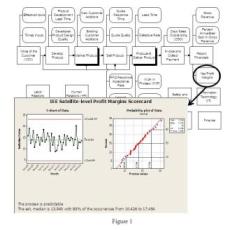

With the IEE system, satellite-level financial metrics have similar reporting to 30,000-foot-level operational metrics. These metrics can also be linked to the value chain through a "mouse click," as illustrated in Figure 1.
To be successful, organizations need to focus on the big picture. One measure of success is that the enterprise’s satellite-level metrics are performing at a level that is considered satisfactory; e.g., mean monthly profit margins as reported in Figure 1. If these financial metrics are not at a desired level, the organization as a whole needs to be assessed to determine which business and process areas need enhancement so that these measurements are most positively impacted.
Once enterprise-beneficial-improvement areas are identified, the next question is what can be done to ensure timely completion of identified projects, a challenge that exists in many organizations. To address this question, let’s start by examining the following quotes:
Vince Lombardi changed the National Football League (NFL) Green Bay Packers, who were perpetually losing at the time, into an NFL dynasty. Coach Lombardi said, "If you are not keeping score, you are just practicing."
Dr. Edwards Deming stated, "If you have a stable system, then there is no use to specify a goal. You will get whatever the system will deliver. A goal beyond the capability of the system will not be reached. . . . If you do not have a stable system, then there is again no point in setting a goal. There is no way to know what the system will produce: it has no capability."
Dr. Lloyd S. Nelson stated: "If you can improve productivity, or sales, or quality, or anything else, by (e.g.,) five percent next year without a rational plan for improvement, then why were you not doing it last year?"
To me these quotes suggest that:
When organizations establish scorecard goals, much care needs to be exercised. Goals should be SMART; i.e, Specific-Measurable-Actionable-Relevant-Time Based. However, these guidelines are often violated. Arbitrary goals set for individuals or organizations can be very counterproductive and costly.
The implication of Nelson’s statement is that simple goal setting alone will not yield an improved output. For an enhanced process response, organizations need to give due diligence to bettering the process. Focus needs to be given to the creation of more customers and cash (MC2) not the simple creation of arbitrary goals throughout the organization, which can lead to the wrong activities or strategies that often lead to interpretation and action-item inconsistencies.
In step two of the nine-step Integrated Enterprise Excellence (IEE) system, satellite-level (financial) and 30,000-foot-level (operational) scorecard/dashboard metrics are examined over time before financial goals are established. The assessment of these non-calendar bounded metrics helps with the creation of SMART goals. This assessment could lead to the following mean monthly satellite-level metric goals within a certain period of time:
Organizational 30,000-foot-level, value-chain metrics would then be assessed to determine which of these measures would be assigned an improvement goal for the purpose of enhancing the overall satellite-level financial metrics. Performance measurement improvements would be demonstrated by a shift to a new, enhanced level of 30,000-foot-level performance.
Value-chain metrics need to have a process owner who is held accountable for having any assigned metric-goal-driven process improvement projects timely completed so that their measurement’s targets are achieved. The process owner can expedite the completion of projects in his area, when he works with practitioners in following a consistent roadmap for project execution; e.g Integrated Enterprise Excellence Volume III .
Organizations can use the IEE system to address not only enterprise-process-goal-setting challenges but overall business management issues, as well.
References:
Much of the content in this blog is taken from:
Integrated Enterprise Excellence Volume II
Integrated Enterprise Excellence Volume III

Recent Comments
Therefore great deal to take place over kinds...
Gee… I translate writes on a similar to...
As it turned out, it is quite possible...
For some it is significant, and so research...
nike tiffany and co jacket